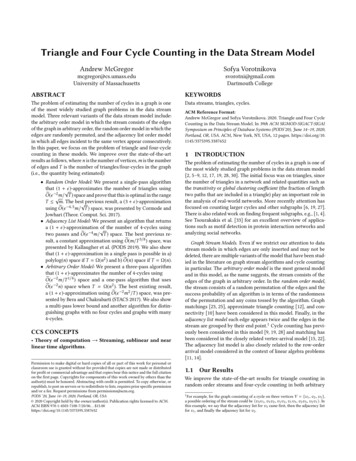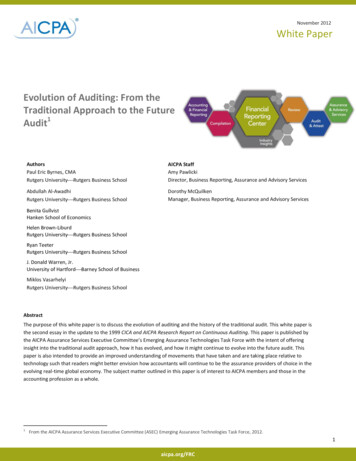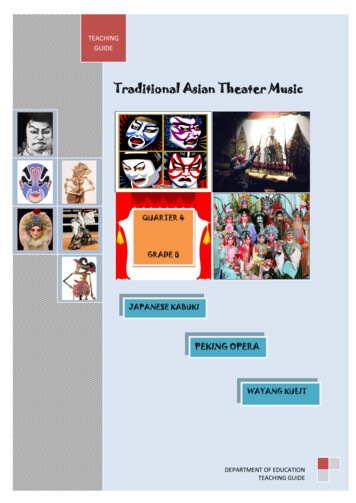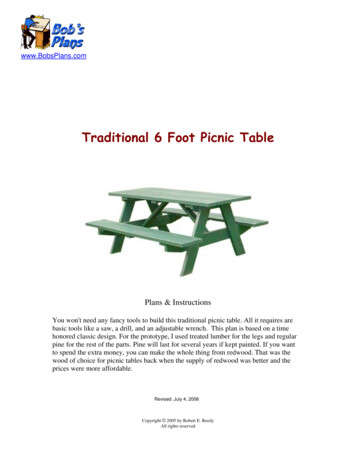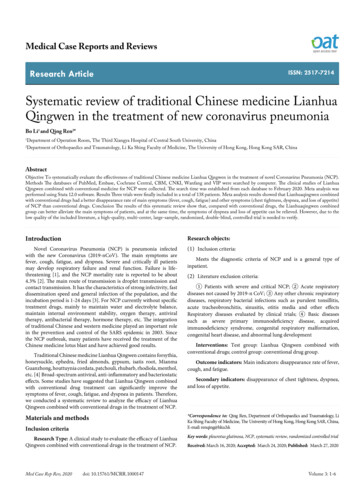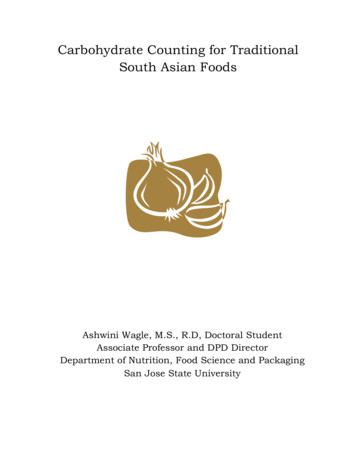
Transcription
Carbohydrate Counting for TraditionalSouth Asian FoodsAshwini Wagle, M.S., R.D, Doctoral StudentAssociate Professor and DPD DirectorDepartment of Nutrition, Food Science and PackagingSan Jose State University
PrefaceThe Carbohydrate Counting tool was developed to meet the needs of the South Asianpopulation and is an original intellectual product of the author, Ashwini Wagle, MS, RD,Associate Professor and DPD Director, Department of Nutrition, Food Science and Packaging atSan Jose State University. The 4th edition and revised version was developed by the mainauthor with assistance of Tanay Prabhu, BS Student in Biological Sciences, Drexel University,Philadelphia. The previous versions of the tool were developed with the assistance of graduatestudents Sajida Arsiwala, MS, RD and Bhavna Subhedar, MS and Dr. Kathryn Sucher, Sc.D, RD,Professor Emeritus, Department of Nutrition, Food Science and Packaging at San Jose StateUniversity.About the AuthorAshwini Wagle, MS, RD is an Associate Professor and Director for the Didactic Program inDietetics (DPD) in the Department of Nutrition, Food Science and Packaging at San Jose StateUniversity. Ashwini Wagle earned her MS in Food and Nutrition from Indiana University ofPennsylvania (IUP) in 93'and is currently a doctoral student in Educational Leadership (Ed.D) atUniversity of New England. She comes to San Jose State University with over ten yearexperience as a registered dietitian (RD) in several skilled nursing facilities and acute carehospitals in the San Francisco Bay Area. Ashwini Wagle is also involved with several on-campusand off-campus organizations and serves on the committees for organizations such as the SouthAsian Heart Center at El Camino Hospital, Center for Healthy Aging in Multicultural Populations(CHAMP), Education Committee of the California Dietetic Association (CDA), San Jose PeninsulaDistrict of California Dietetic Association (SJPD), Cal-Pro Net Center.Her basic areas of interest and research are food and culture, traditional health beliefs,practices, and food behaviors for multiple ethnic populations especially South Asians, foodinsecurity and hunger, and foodservice systems. She has published several articles in peerreviewed scientific research journals and has over fifty abstracts published and presented atnational and state conferences.Contact Information:Ashwini Wagle, MS, RD, Doctoral StudentAssociate Professor and DPD Director,Department of Nutrition, Food Science and Packaging,San Jose State UniversityEmail: ashwini.wagle@sjsu.eduCopyright 2014 Ashwini Wagle, M.S., R.D and Department of Nutrition, Food Science and Packaging,SJSU All Rights Reserved2
Carbohydrate CountingSome Facts about Carbohydrates (also called carbs or CHO)Carbohydrates are the body’s main source of fuel. Carbohydrates are found in grains, fruits,vegetables, and milk and they provide energy, vitamins, minerals and fiber. Carbohydratesraise your blood sugar more than any other nutrient. When you eat any type of carbohydrates,they are broken down into glucose and it enters your bloodstream. The hormone insulin helpsthe cells in your body to take up this glucose and use it for energy.If carbohydrates raise blood glucose does that mean that as a diabetic, you should stay awayfrom them? The low-carb diets that are popular today would make you think they are ideal fordiabetics. The fact is that current scientific knowledge does not support the long term use oflow-carb diets especially in type 2 diabetics. Carbohydrates from fruits, vegetables, wholegrains, and low-fat dairy foods are a part of a healthy diet.What about Sugar?In the past, people with diabetes were told to ‘hold the sugar’. Current scientific literature hasfound little truth in the notion that sugars raise blood glucose any more than othercarbohydrates. The most important factor in controlling blood sugar is the amount ofcarbohydrates eaten in a meal and not the type. What that means is not that you can eatsweets and sugars liberally, but that an occasional sweet treat may be okay as long as you makeadjustments in the total amount of carbohydrate eaten in that meal.Carbohydrate CountingCarbohydrate counting is not a diet, it is a way of planning your carbohydrate intake to manageyour blood sugar levels. It places importance in keeping the carbohydrate content of your mealsand snacks consistent from day to day. Eating the same amount of carbohydrate for your mealsand snacks everyday ensures better blood glucose control. The American Diabetes Associationand many health professionals use carbohydrate counting to teach patients how to controltheir blood glucose. Carbohydrate counting ensures that you can have variety and flexibility inyour diet and most importantly can follow your traditional diet.How many Carbs am I allowed to eat?You can consult a registered dietitian for an individualized diet plan that fits your needs likeweight loss etc. Most men however, need about 4-5 carbs (60-75gms) at each meal. Mostwomen generally need about 3-4 CHO choices (45-60gms) at each meal. If you eat snacks,1-2 CHO choices (15-30g) are adequate.Copyright 2014 Ashwini Wagle, M.S., R.D and Department of Nutrition, Food Science and Packaging,SJSU All Rights Reserved3
What is a Carbohydrate serving?A carbohydrate choice is a serving of food which contains 15 gms of carbohydrate. Look at thefood label and measure how much you will be eating. There are 2 things to locate on the foodlabel; the serving size, and the number of gms of carbohydrate per serving. The number of gmsof carbohydrates can be used to calculate the number of carbohydrate choices in the amountyou are eating, hence read the food label.In the example below, if you were to eat 2 cups of cereal, which means you had two servings,you will be consuming twice the total carbohydrate listed on the food label which would totalto 86 gms of carbohydrates.How to Count CHOServingsWhat will I need to get started?0-5gmsfree food (do not 0gms4You will need a set of measuring cups and spoons plus a food scale. When you are justbeginning to count carbs, you may not be able to accurately estimate a serving size. Try this;scoop out one serving of rice which should be about 1/3 cup. Now do the same thing using a1/3rd cup measure and see the difference. Once you have been doing it for a few days you willbecome better at it and will no longer need the measuring cups. You can also invest in thecarbohydrate counting resource books given at the end.What about proteins and fats?Foods in the fat and protein category do not affect blood glucose directly. Foods in thiscategory include meat, poultry, eggs, tofu, peanut butter, most cheeses and fats such as butter,Copyright 2014 Ashwini Wagle, M.S., R.D and Department of Nutrition, Food Science and Packaging,SJSU All Rights Reserved4
margarine and oils. These foods contain negligible amounts of carbohydrate, thus you do notneed to worry about them. That does not mean that you can eat as much fat or protein as youlike. Keep in mind that most adults need only about 6oz of meat or meat alternatives each day.A 3 oz serving of meat is the size of a deck of cards. Make heart healthy choices wheneverpossible. Healthy eating involves more than just carbohydrate counting. The next section willhelp you make the right choices.Some tips and suggestions: Eat a variety of foods. Try to include 5 servings of fruits and vegetables, 6 servings ofgrains (3 whole grains) and 3 servings of low fat dairy daily.Substitute brown rice for white rice. Generally people with diabetes are told to avoidrice altogether. This is a misconception. You can eat rice in reasonable quantities as longas the total carbohydrate for that meal does not exceed your limit.Instead of eating only rice, try other grains such as cracked wheat, barley and quinoa(available in most stores and very high in protein). Use them like you would use rice inpulaos etc.Avoid starchy vegetables. When using potatoes, yams or other starchy vegetable, alwaysremember to cut down on the amount of rice/roti eaten at that meal. Better still, selectgreen vegetables in place of starchy ones.Use green vegetables freely and prepare them in a small amount of oil.Avoid frying as a cooking method; learn to use other methods such as dry roasting,baking etc.Try to cook with a minimum amount of oil. Use olive or canola oils as they are high inmonounsaturated fats which are good for your heart. Avoid ghee, butter and cream incooking.Switch to skim or 1% milk and yogurt. When making desserts like kheer, use 1% milk orevaporated skim milk and use artificial sweeteners. Whole milk and yogurt and productsmade with them like paneer are high in saturated fats, which raise cholesterol in yourblood. Try making your own paneer, chenna with low fat milk.Tofu is a good source of high-quality protein especially for vegetarians. Try using it inplace of paneer for making dishes like palak paneer.Avoid coconut milk/cream or use less than called for in the recipe. Coconut milk is highin saturated fat.Use 100% whole wheat chapatti flour for making rotis/phulkas. Avoid putting anyghee/oil when making rotis.How will I know how much Carbohydrate is in a food?For packaged foods, please look at the food label and find out how much carbohydrate is in thefood. Information about carbohydrate content of popular American foods can be easily foundin carb counting books and pamphlets. Nutritional information on traditional South Asian foodsis hard to come by. The following list will help you get started.Copyright 2014 Ashwini Wagle, M.S., R.D and Department of Nutrition, Food Science and Packaging,SJSU All Rights Reserved5
Starch ListBreads: 15 g Carb (1 carb choice)(Each Serving 15 gms Carbohydrate, 3 gms protein, 0-1 gm Fat, 80 calories)FoodBagelBiscuitBread sticks (crisp)Bread (white, wheat, rye, wholegrain)ChapatiCornbreadCroissantDinner Roll (Pav)DosaEnglish MuffinHamburger/Hot Dog bunIdliMuffinNaanPancakePaneer ParathaParatha Plain or TheplaPita BreadPotato ParathaPurisRaisin Bread, unfrostedRava IdlisReduced-calorie BreadRoti (Bajra, Makai, Jowar, Multi-grain)Stuffing, breadTaco shell or tostada shellTortilla:Corn or Flour, 6” acrossFlour, 10” acrossWaffleAmount½ (1 oz)1, 2.5” diameter2, 4” long and ½” thick (⅔ oz)1 slice (1 oz)1, 6” diameter1 ¾” (1½ oz)1 small (1 oz)*1 small (1 oz)1 approx 10”diameter½ (1 oz)½ (1 oz)1 small (1½ oz)1 small*¼th of 8” x 2”1, 4” diameter x ¼” thick½, 6” diameter*¾ , 6” diameter*½ of 6”¾ , 6” diameter*2, 5”*1 slice (1 oz)2 mini (1½ oz)2 slices (1½ oz)¾” of 6” diameter⅓ cup2 crisp shells, 5” across1⅓1, 4” square or diameterCopyright 2014 Ashwini Wagle, M.S., R.D and Department of Nutrition, Food Science and Packaging,SJSU All Rights Reserved6
Starchy Vegetables: 15 g carb (1 carb choice)(Each Serving 15 gms Carbohydrate, 3 gms protein, 0-1 gm Fat, 80 calories)FoodAloo GobiBaked BeansCassavaCorn on the CobCornFrench Fries*Hash Browns*Amount1 cup⅓ cup⅓ cup1, 6” (5 oz)½ cup10 (2 oz)½ cupHominy, CannedMixed Veg (Corn, Peas)ParsnipsPeas, GreenPlantain (green)Plantain (ripe)Potato Sabji*Potato, Boiled or BakedPotatoes, MashedPumpkin, Canned (No Sugar Added)SuccotashSweet Potatoes¾ cup1 cup½ cup½ cup⅓ cup⅓ cup½ cup1 small (3 oz)½ cup1 cup½ cup½ cupVegetable KormaVegetable Tofu Stir Fry½ cup1¼ cupWinter Squash (Acorn or Butternut)1 cupYams½ cupCereals/Grains: 15g Carb (1 carb choice)(Each Serving 15 gms Carbohydrate, 3 gms protein, 0-1 gm Fat, 80 calories)FoodAviyalBarley, CookedBarley, RawBiryani/Pulao* MeatBisi Bhela BhathBran CerealsAmount½ cup½ cup20 gms½ cup⅓ cup½ cupCopyright 2014 Ashwini Wagle, M.S., R.D and Department of Nutrition, Food Science and Packaging,SJSU All Rights Reserved7
BulgurCereals½ cup-Bran-Oatmeal, Cooked-Puffed-Shredded wheat, plain-Ready to eat, unsweetened-Sugar-frostedCooked cerealsCornmeal, DryCouscous, CookedCouscous, RawCracked Wheat (Dalia Cooked)Cracked Wheat (Dalia)Dhansak*DhoklaGranola, Regular or Low FatGrape-Nuts Grits, CookedKashaKichadi/Khichri CookedMatki UsalMillet, Finger (Ragi/Nachni) CookedMillet, Finger (Ragi/Nachni) RawMillet, Pearl (Bajra) CookedMillet, Pearl (Bajra)MuesliPasta (Cooked)Polenta, CookedPolenta, RawQuinoa, CookedQuinoa, RawRice Flakes (Poha Cooked)Rice Flakes (Poha)Rice, Brown CookedRice, Brown RawRice, PuffedRice, White CookedRice, White RawTamarind Rice½ cup½ cup1½ cupscup¾ cup½ cup½ cup1½ cup⅓ cup20 gms½ cup20 gms½ cup1, 1” square¼ cup¼ cup½ cup½ cup½ cup½ cup½ cup20 gms⅓ cup20 gms¼ cup½ cup⅓ cup20 gms⅓ cup20 gms½ cup20 gms⅓ cup20 gms1½ cup⅓ cup20 gms⅓ cupCopyright 2014 Ashwini Wagle, M.S., R.D and Department of Nutrition, Food Science and Packaging,SJSU All Rights Reserved8½
Semolina (Sooji/Rava)Shredded WheatSorghum (Jowar) CookedSorghum (Jowar) RawTabbouleh, PreparedTabbouleh, RawTapioca (Sabudana), UncookedUpma (Cooked)Uttapam, Vegetable or Mini UttapamWheat Germ, DryWheat VermicelliWheat, SproutedWhole Wheat Flour (Atta)All-Purpose Flour (Maida)Wild Rice, Cooked20 gms½ cup½ cup20 gms½ cup20 gms2 tbsp½ cup1, 4”3 tbsp20 gms½ cup25 gms/3 tbsp25 gms/3 tbsp½ cupPulses/Dals/Beans: 15 g Carb (1 carb choice)(Each Serving 15 gms Carbohydrate, 7 gms protein, 0-3gm Fat, 125 calories)FoodBengal Gram (Chole, Chana, Chickpeas Garbanzo)CookedBengal Gram (Chole, Chana, Chickpeas Garbanzo)RawBlack Eyed Peas (Chavli) CookedBlack Eye Peas (Chavli) RawBlack Gram (Urad Dal) CookedBlack Gram (Urad Dal) RawChick Pea Flour (Besan)Chicken Chettinad CurryChicken CurryChicken Noodle SoupCow Peas (Lobia) RawCow Peas (Lobia) RawDhansak*Green Gram (Mung Dal) CookedGreen Gram (Mung Dal) RawHorse Gram (Kulith) CookedHorse Gram (Kulith) RawHummusKidney Bean (Rajma) RawAmount½ cup25 gms½ cup20 gms½ cup25 gms⅓ cup1¼ cup1¼ cup¾ cup½ cup25 gms½ cup½ cup25 gms½ cup25 gms⅓ cup25 gmsCopyright 2014 Ashwini Wagle, M.S., R.D and Department of Nutrition, Food Science and Packaging,SJSU All Rights Reserved
your diet and most importantly can follow your traditional diet. How many Carbs am I allowed to eat? You can consult a registered dietitian for an individualized diet plan that fits your needs like weight loss etc. Most men however, need about 4-5 carbs (60-75gms) at each meal. Most women generally need about 3-4 CHO choices (45-60gms) at each meal. If you eat snacks,

